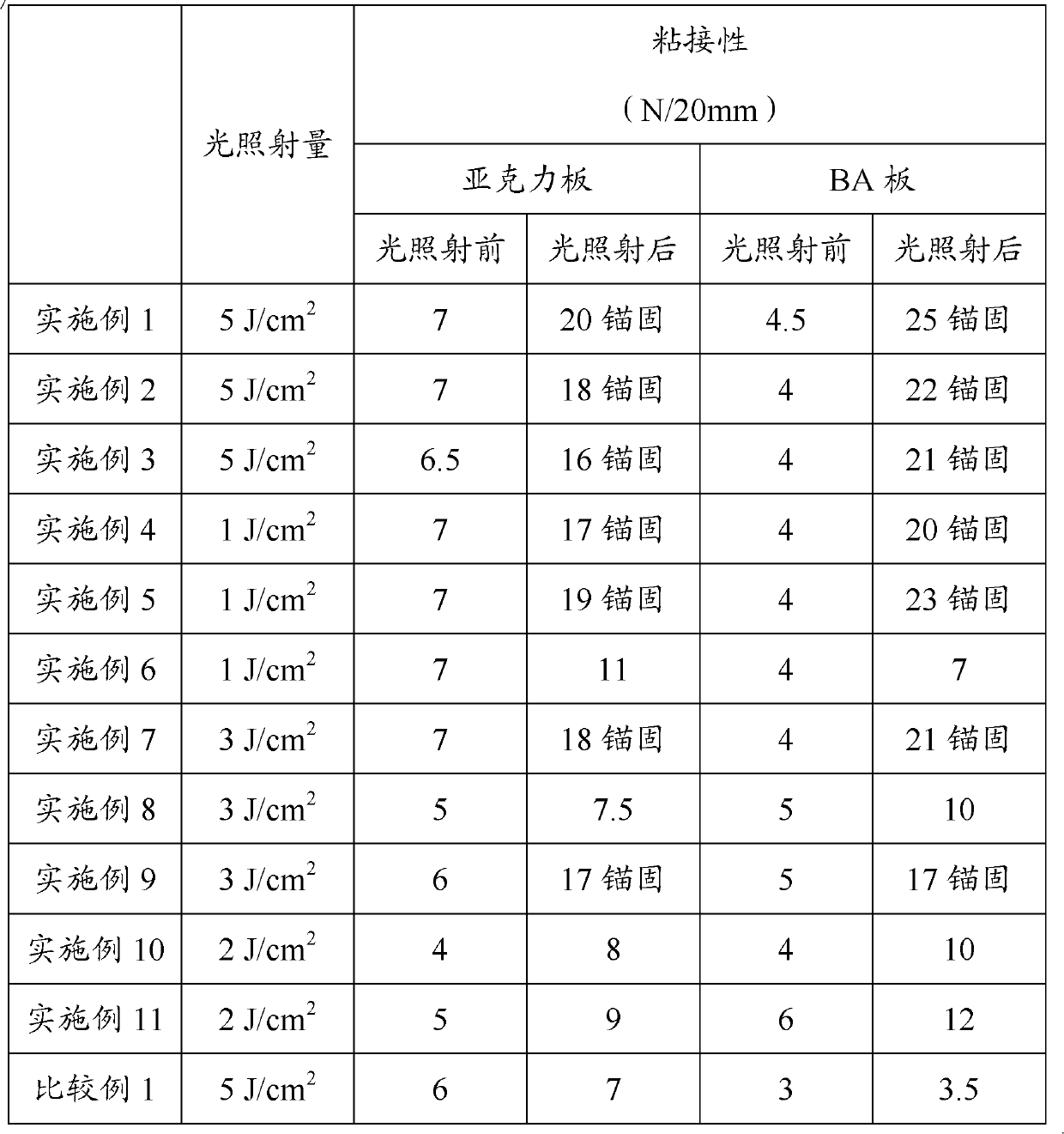Photocurable adhesive composition, photocurable adhesive layer, and photocurable adhesive sheet
An adhesive layer, light-curing technology, applied in the direction of adhesive types, non-polymer adhesive additives, adhesive additives, etc., can solve problems such as difficulty in preventing glue leakage, and achieve excellent adhesion and heat resistance. Excellent performance and easy handling
- Summary
- Abstract
- Description
- Claims
- Application Information
AI Technical Summary
Problems solved by technology
Method used
Image
Examples
Embodiment 1
[0137] (Preparation of Acrylic Polymer)
[0138] In a four-necked flask equipped with a stirring blade, a thermometer, a nitrogen inlet tube, and a condenser, 99 parts by weight of n-butyl acrylate, 1 part by weight of 4-hydroxybutyl acrylate, and 0.1 part by weight of 2,2' as a polymerization initiator - Azobisisobutyronitrile was charged together with 200 parts by weight of ethyl acetate, nitrogen replacement was carried out for 1 hour while slowly stirring, and then the liquid temperature in the flask was kept at around 55°C to carry out polymerization reaction for 10 hours , to prepare an acrylic polymer solution with a weight average molecular weight of 1.8 million. The glass transition temperature of the obtained acrylic polymer was 225K.
[0139] (Preparation of graft polymer)
[0140] The obtained acrylic polymer solution was diluted with ethyl acetate so that the solid content would be 25%, to prepare a diluted solution (I). In a four-necked flask equipped with sti...
Embodiment 2
[0147] (Preparation of Acrylic Polymer)
[0148] In a four-necked flask equipped with a stirring blade, a thermometer, a nitrogen inlet tube, and a condenser, 99 parts by weight of n-butyl acrylate, 1 part by weight of 4-hydroxybutyl acrylate, and 0.1 part by weight of 2,2' as a polymerization initiator - Azobisisobutyronitrile was charged together with 200 parts by weight of ethyl acetate, nitrogen replacement was carried out for 1 hour while slowly stirring, and then the liquid temperature in the flask was kept at around 55°C to carry out polymerization reaction for 10 hours , to prepare an acrylic polymer solution with a weight average molecular weight of 1.8 million. The glass transition temperature of the obtained acrylic polymer was 225K.
[0149] (Preparation of graft polymer)
[0150] The obtained acrylic polymer solution was diluted with ethyl acetate so that the solid content would be 25%, to prepare a diluted solution (I). In a four-necked flask equipped with sti...
Embodiment 3
[0157] (Preparation of Acrylic Polymer)
[0158] In a four-necked flask equipped with a stirring blade, a thermometer, a nitrogen inlet tube, and a condenser, 99 parts by weight of n-butyl acrylate, 1 part by weight of 4-hydroxybutyl acrylate, and 0.1 part by weight of 2,2' as a polymerization initiator - Azobisisobutyronitrile was charged together with 200 parts by weight of ethyl acetate, nitrogen replacement was carried out for 1 hour while slowly stirring, and then the liquid temperature in the flask was kept at around 55°C to carry out polymerization reaction for 10 hours , to prepare an acrylic polymer solution with a weight average molecular weight of 1.8 million. The glass transition temperature of the obtained acrylic polymer was 225K.
[0159] (Preparation of graft polymer)
[0160] The obtained acrylic polymer solution was diluted with ethyl acetate so that the solid content would be 25%, to prepare a diluted solution (I). In a four-neck flask equipped with stirr...
PUM
| Property | Measurement | Unit |
|---|---|---|
| thickness | aaaaa | aaaaa |
Abstract
Description
Claims
Application Information
 Login to View More
Login to View More - R&D
- Intellectual Property
- Life Sciences
- Materials
- Tech Scout
- Unparalleled Data Quality
- Higher Quality Content
- 60% Fewer Hallucinations
Browse by: Latest US Patents, China's latest patents, Technical Efficacy Thesaurus, Application Domain, Technology Topic, Popular Technical Reports.
© 2025 PatSnap. All rights reserved.Legal|Privacy policy|Modern Slavery Act Transparency Statement|Sitemap|About US| Contact US: help@patsnap.com


